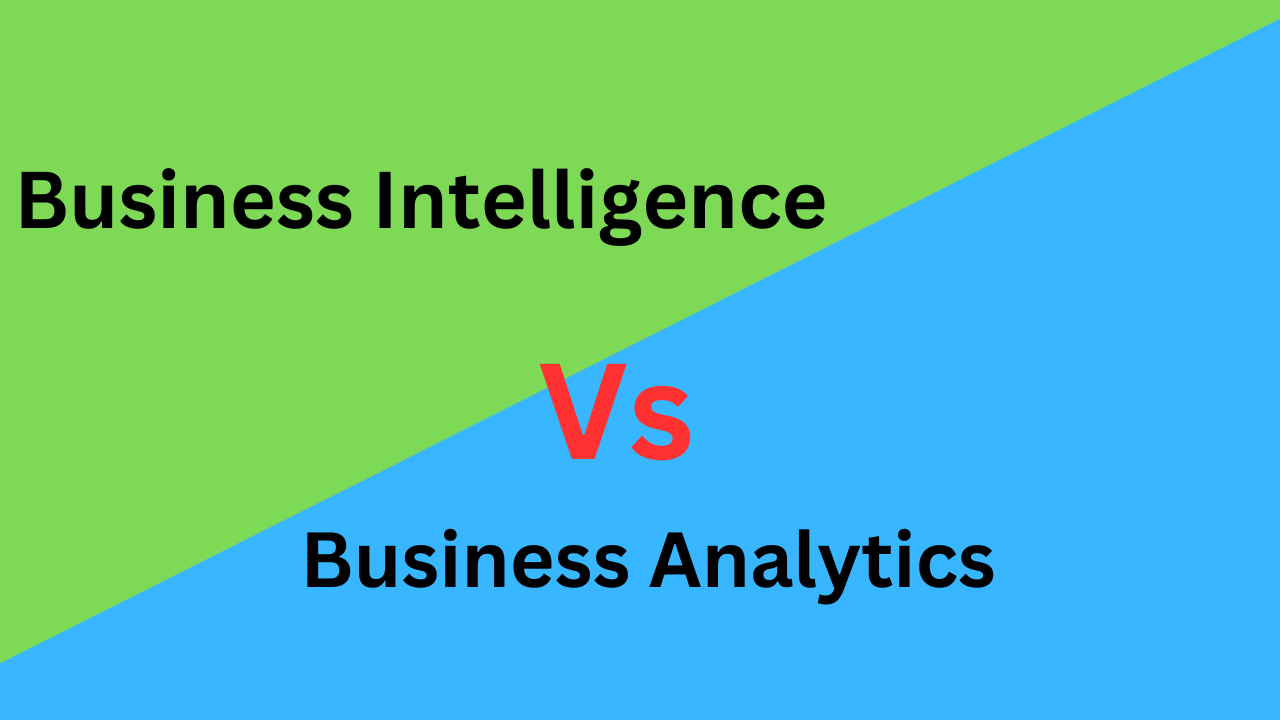What is the main difference between business intelligence and business analytics? The former analyses the past and present to drive current business needs, while the latter analyses past data to drive the current business.
Every business create an overwhelming amount of data daily. The data helps business owners make informed decisions by identifying problems that could hinder profit maximization. Business intelligence and analytics are data-management solutions that provide vital insights.
Telling the difference between these two solutions can be challenging. You need to undertake business intelligence and analytic courses to sharpen your skills. This article provides detail insights about their differences and similarities.

Difference Between Business Intelligence and Business Analytics With Table
| Basic Terms | Business Intelligence | Business Analytics |
| Meaning | Analyses the present and past to drive current business needs. | Analyses past data to drive current business. |
| Use | Run current business operations | To change business operation and improve productivity |
| Ease of Operation | For current business operation | For future business operation |
| Tools | SAP Trade Objects, QlikSense, TIBCO, PowerBI etc. | Word handling, Google docs, MS Visio, MS Office Instruments etc. |
| Application | Applicable to all large scale companies to run the current business operations. | Applicable to companies whose future growth and productivity is the goal. |
| Field | Subset of business analytics. | Contain data warehouse and information management |
| Key Skills | Data collection and Management, Data Stockroom concepts, Understanding of diverse data sources and exchange applications, Domain and business information. | Good verbal communication, capacity to run partner meetings, and excellent listener. |
What Is Business Intelligence?
Business Intelligence (BI) refers to the technology-driven process of collecting, analyzing, and presenting business data to facilitate informed decision-making.
It empowers organizations to transform raw data from various sources into actionable insights to aid executives, managers, and other stakeholders in understanding their operations.
BI systems encompass data gathering, cleaning, integration, and analysis through tools like data warehouses, dashboards, reports, and data visualization software.
These tools enable users to uncover patterns, correlations, and anomalies within their data, allowing them to recognize market trends, customer behaviors, and operational inefficiencies.
BI streamlines the conversion of complex data into easily comprehensible formats, supporting data-driven decision-making processes across an organization.
This capability enhances agility, competitiveness, and overall performance. The enterprises leverage the data as a valuable asset to achieve business goals.
What Is Business Analytics?
Business Analytics (BA) refers to the systematic exploration, interpretation, and transformation of data to derive meaningful insights that drive informed business decisions and strategies.
It involves the application of statistical, mathematical, and computational techniques to analyze historical and current data, uncover patterns, trends, and correlations, and predict future outcomes.
Business Analytics delves deeper by employing advanced techniques such as predictive modeling, data mining, machine learning, and optimization.
These methods enable organizations to make proactive decisions, anticipate market shifts, optimize processes, and enhance overall efficiency.
Business Analytics plays a pivotal role in transforming raw data into actionable knowledge for aiding decision-makers in recognizing opportunities and mitigating risks.
By harnessing the power of data-driven insights, businesses can adapt swiftly to changing conditions, optimize their operations, and innovate in their products and services.
Main Difference Between Business Intelligence and Business Analytics
- I examines the past and present to drive the current business needs while B.A analyses the past data to drive current business.
- I run current business organization while B.A tend to change business operations and improve productivity.
- I focuses to ease the current business operation while B.A for future business operation.
- I applies to all large scale companies to run current operations while B.A applies to companies where future growth and productivity is the goal.
- I is a subset of B.A while B.A contain data warehouse and information management.
Similarities Between Business Intelligence and Business Analytics
- Both BI and BA involve the utilization of data to gain insights into business operations and performance.
- Both aim to support informed decision-making by providing relevant and accurate information to stakeholders.
- Both involve data processing techniques to transform raw data into actionable insights.
- Both utilize data visualization tools to present complex data in easily understandable formats, aiding comprehension.
- Both BI and BA have a strong business focus, aiming to improve efficiency, identify opportunities, and optimize processes.
- Both analyze historical data to uncover trends, patterns, and anomalies that can inform future strategies.
- Both rely on technology solutions, such as software, databases, and analytical tools, to process and analyze data effectively.
- Both aim to enhance organizational performance, competitiveness, and strategic planning through data-driven insights.
- Both require data integration from various sources to provide a comprehensive view of the business landscape.
- Both are geared towards meeting the needs of different users within an organization, from executives to analysts, by providing tailored insights.
Final Thoughts from Experts
Business Intelligence (BI) and Business Analytics (BA) serve distinct purposes in the realm of data-driven decision-making. BI primarily focuses on collecting, organizing, and presenting historical and current data to provide descriptive insights into business operations.
BA delves deeper into data analysis by employing advanced techniques to predict future trends, identify patterns, and optimize processes. It enables organizations to make proactive decisions based on predictive and prescriptive insights.
Both BI and BA play vital roles in modern decision-making, offering the tools needed to harness the potential of data for achieving operational excellence and competitive advantage.
People Who Read This Also Read:
- Difference Between Traditional Commerce and E-Commerce (With Table)
- Difference Between E-Commerce and M-Commerce (With Table)
- Difference Between E-Commerce and E-Business (With Table)